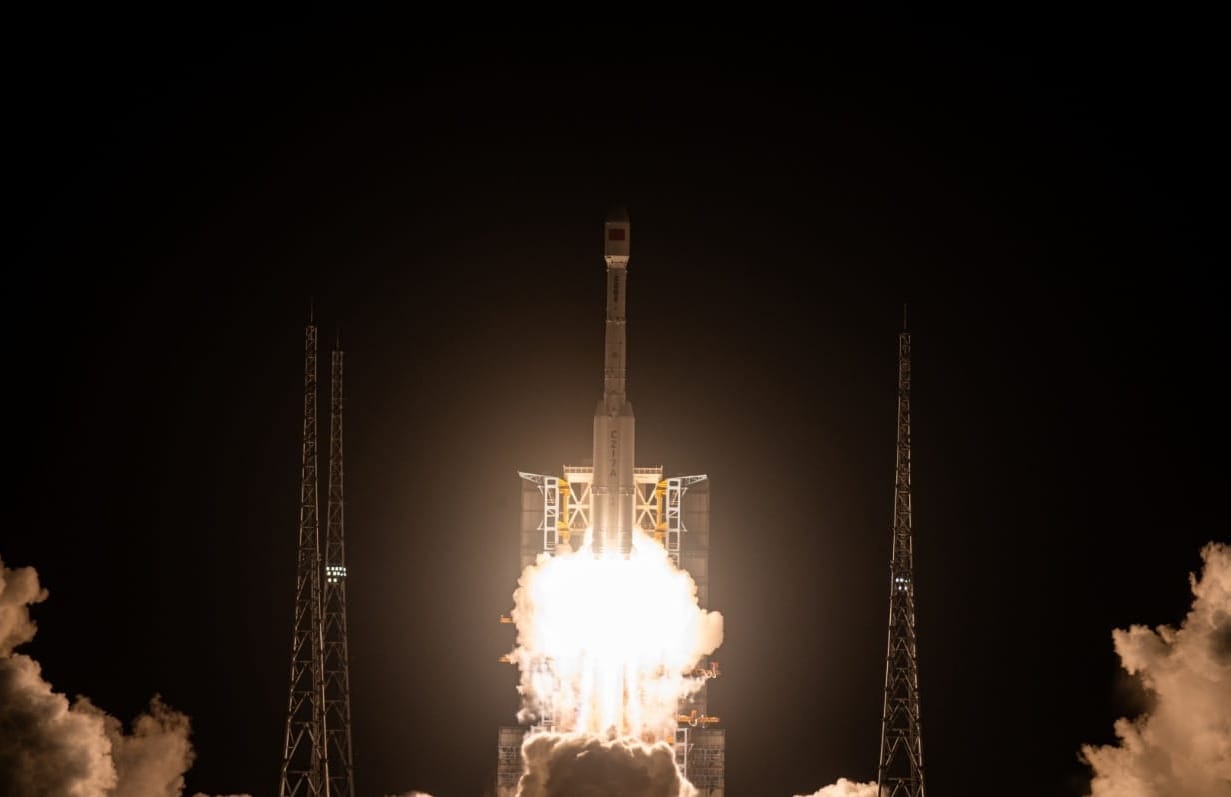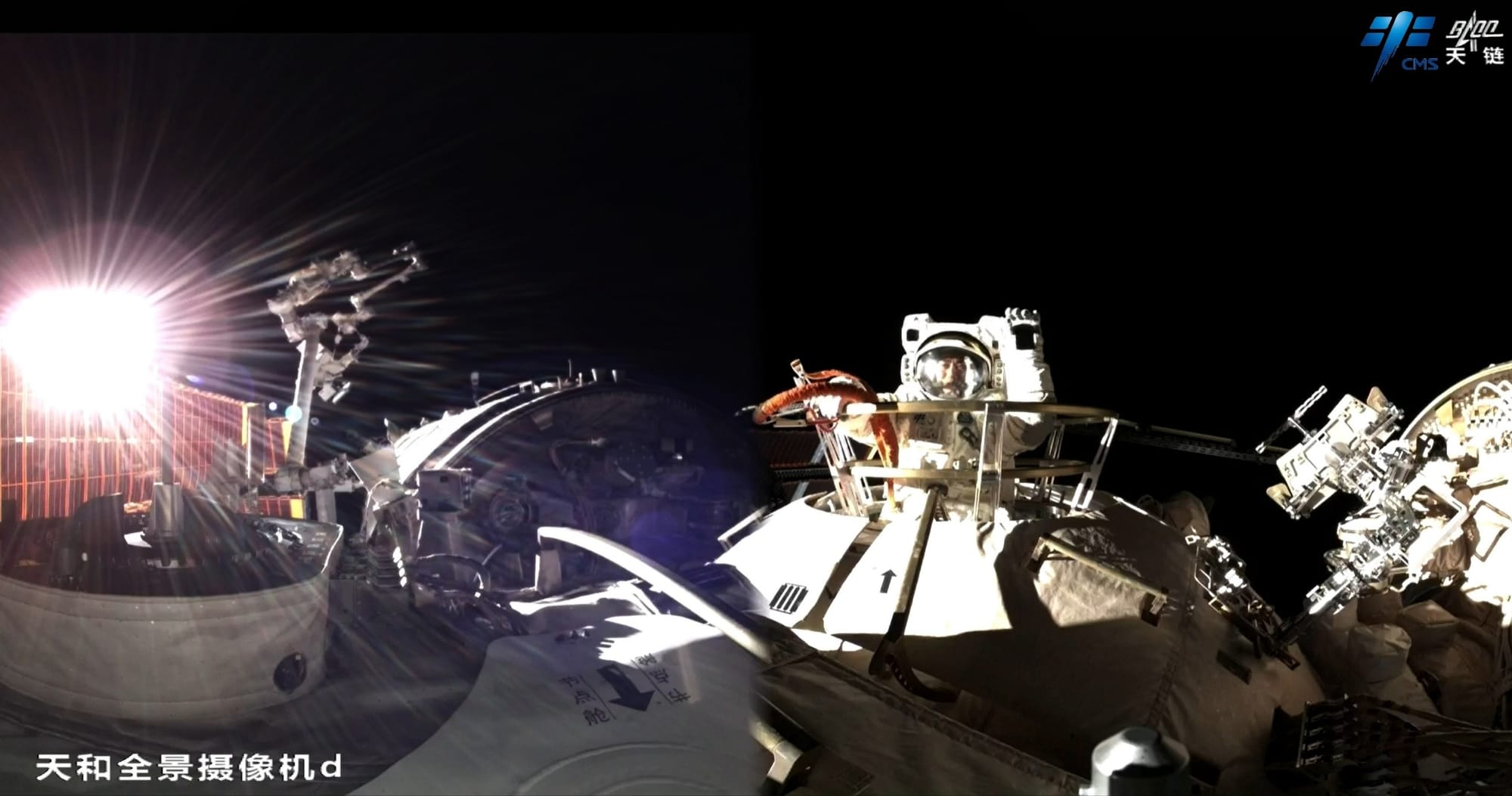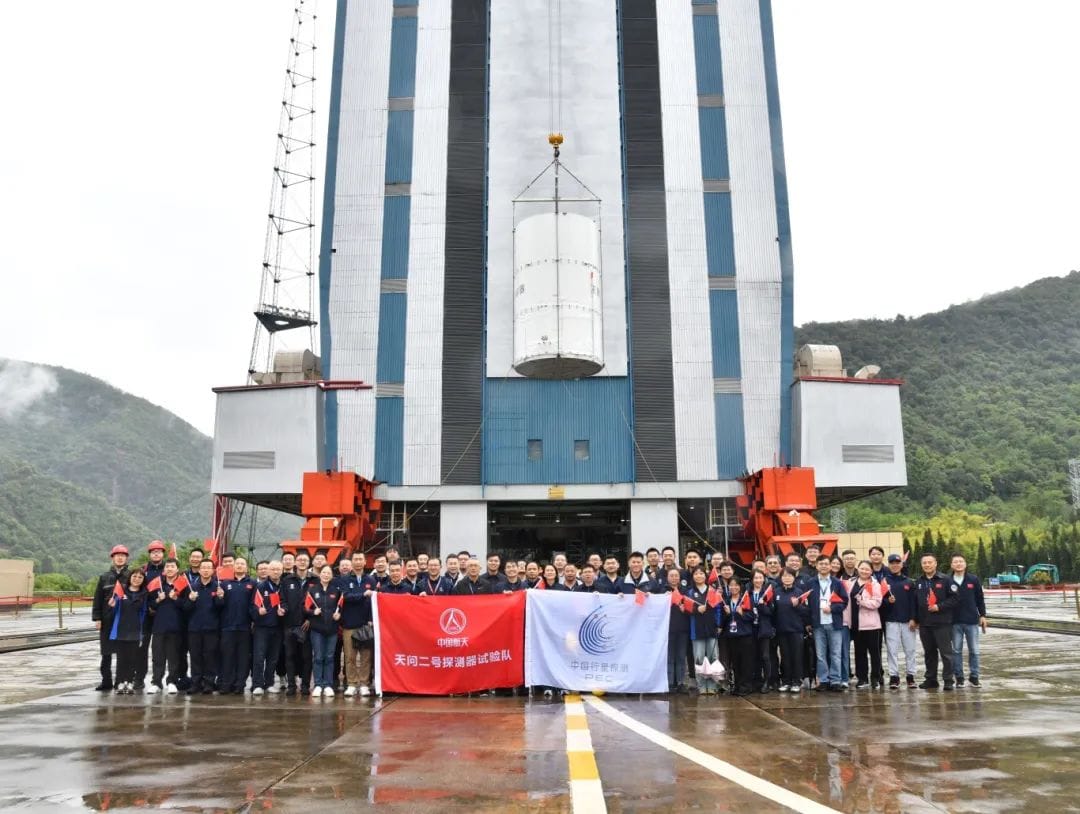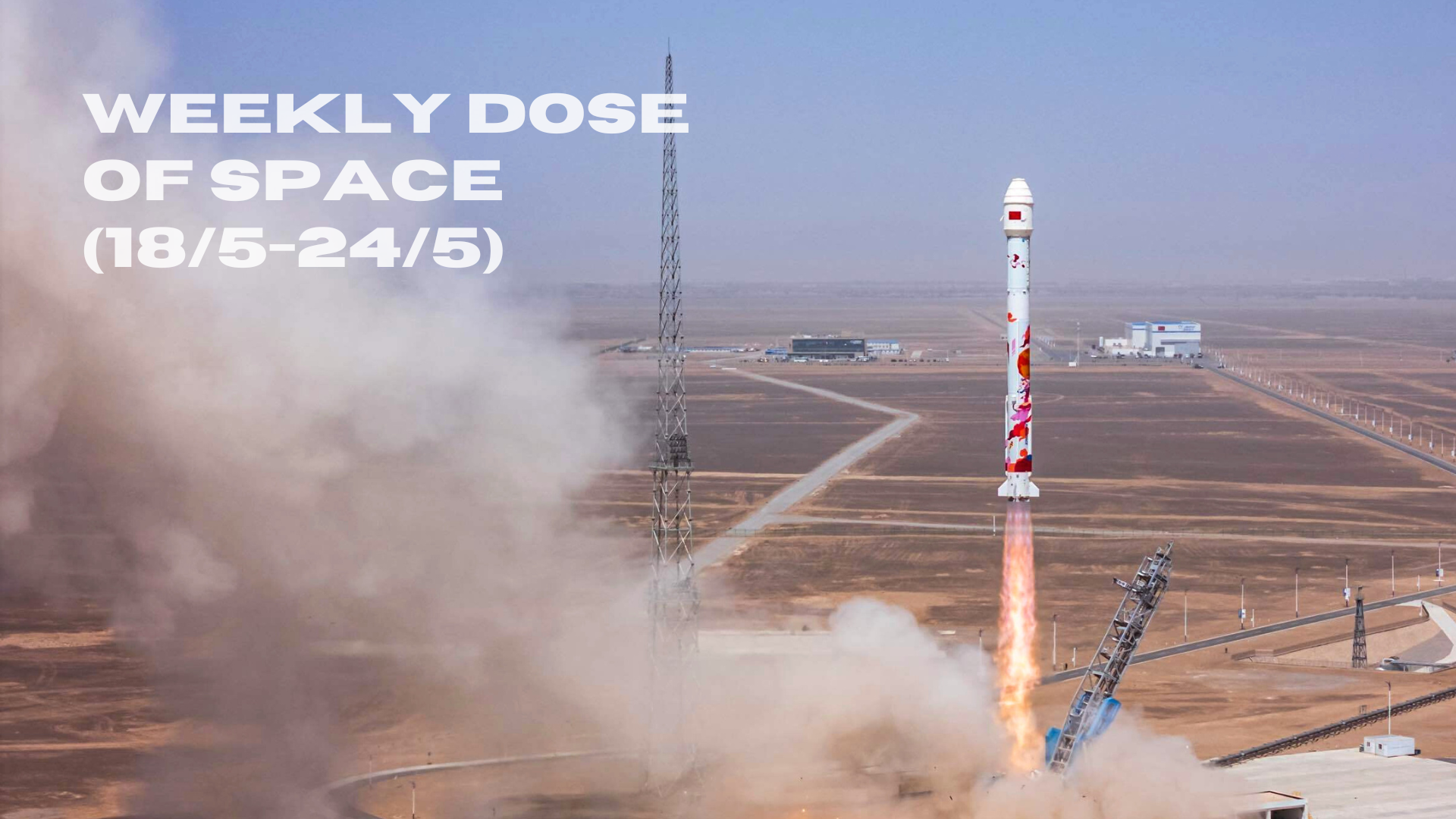Table of Contents
Welcome back to Weekly Dose of Space! This week saw seven launches taking place worldwide, with one failure. News from the week saw the Shenzhou-20 taikonaut trio conducting their first spacewalk, China's Tianwen-2 asteroid sample return probe preparing for launch, and Jared Isaacman moving closer to being NASA Administrator. As always, we'll also look ahead to what the worldwide launch schedule might look like next week.
Launches This Week
May 18th - PSLV-XL with RISAT-1B
A PSLV-XL rocket launched from the Satish Dhawan Space Centre, in India, hoping to deliver the RISAT-1B synthetic aperture radar imaging satellite to low Earth orbit. Sadly during the third-stage underperformed during its burn, leading in a failure to reach orbit.
May 19th - Ceres-1S with four Tianqi satellites
Galactic Energy's Ceres-1S delivered four Tianqi satellites to a 850-kilometer 45-degree inclination low Earth orbit from the coast of Rizhao in the Yellow Sea. The satellites being launched were Tianqi-16, Tianqi-17, Tianqi-19, and Tianqi-20 for Guodian Gaoke's Internet-of-Things constellation.

May 20th - Long March 7A with ChinaSat-3B
A Long March 7A lifted off from Launch Complex 201 at the Wenchang Space Launch Site carrying the ChinaSat-3B satellite to geostationary transfer orbit. ChinaSat-3B is expected to provide communications, radio, and television transmission services, while complementing ChinaSat-3A.

May 21st - Falcon 9 with Starlink Group 12-15
Twenty-three Starlink satellites were delivered to low Earth orbit atop of a Falcon 9 flying from Space Launch Complex 40, in Florida. Booster B1095 supported this mission, believed to be on its first flight, with a landing downrange on the drone ship 'Just Read The Instructions'.
May 21st - Kinetica-1 for its return-to-flight mission
CAS Space's Kinetica-1 rocket performed its return to flight mission from the Jiuquan Satellite Launch Center, carrying six satellites to sun-synchronous orbit. The satellites onboard were Taijing-3-04, Taijing-4-02A, Xingrui-11, Xingjiyuan-1, Lifang108-001 (also known as Tadahuyang-1), and Xiguang-1-02.

May 23rd - Soyuz 2.1b with Kosmos 2588
A Soyuz 2.1b launched from the Plesetsk Cosmodrome carrying a military spacecraft into low Earth orbit.
May 23rd - Falcon 9 with Starlink Group 11-16
Twenty-seven more Starlink satellites were delivered to low Earth orbit by a Falcon 9 flying from Space Launch Complex 4E, in California. Supporting this launch was booster B1075 for its eighteenth flight, with a landing on the drone ship 'Of Course I Still Love You' down range.
Falcon lands for the 450th time! pic.twitter.com/zoZdVHulSp
— SpaceX (@SpaceX) May 23, 2025
Falcon 9 first-stage booster B1075 landing on the drone ship 'Of Course I Still Love You', via SpaceX on Twitter.
May 24th - Falcon 9 with Starlink Group 12-22
Another twenty-three Starlink satellites were delivered to low Earth orbit with SpaceX's Falcon 9 rocket from Space Launch Complex 40. Booster B1069 supported this launch on its twenty-fourth flight, landing on the drone ship 'A Shortfall Of Gravitas' downrange.
In Other Space News
Shenzhou-20 crew conducts first spacewalk

Chen Dong and Chen Zhongrui conducted the Shenzhou-20 mission's first spacewalk on May 22nd, spending eight hours outside of the space station. Their crewmate, Wang Jie, stayed inside the Tianhe module to support the two spacewalkers.
While outside the space station, the spacewalkers installed various space debris protection devices, having collected them from the Mengtian modules cargo airlock, which placed them outside the station prior. Additionally, inspections of the space stations three modules were conducted to ensure Tiangong is operating as expected, allowing it to remain in orbit into the late 2030s.
In a rarity on Tiangong, the Shenzhou-20 crews spacewalk was performed from the Tianhe module. The last time Tianhe's airlock was used was in December 2021 as all spacewalks since have used the Wentian modules airlock.
Currently, the Shenzhou-20 crew has spent just over one month onboard the space station, with five months left in their mission. Additional spacewalks may occur before the three taikonauts return to Earth in October.
Tianwen-2 prepares for launch

On May 18th, the China Academy of Space Technology shared that the Tianwen-2 probe, which will collect samples from a near-Earth asteroid, was moved to Launch Complex 2 at the Xichang Satellite Launch Center. In the weeks prior, the spacecraft was loaded with its propellant to perform its mission and wrapped up final testing.
Tianwen-2 has been at Xichang since late February for launch preparations. Hazard notices indicate that liftoff for Tianwen-2 atop of the Long March 3B/E could occur as soon as May 28th.
Following launch the spacecraft will begin its long journey out to asteroid 2016HO3, arriving sometime in 2027. While flying alongside the asteroid Tianwen-2 will search for a suitable sampling site before collecting between 200 and 1,000 grams of samples via touch-and-go as well as anchor-and-attach methods. Once these samples are secured in a sample container, the spacecraft will head back toward Earth and drop off the samples around 2029 during a flyby.
After the sample canister is released for retrieval by teams back on Earth, Tianwen-2 will begin its extended mission to asteroid 311P out in the asteroid belt between Mars and Jupiter. Throughout the early 2030s, Tianwen-2 is planned to thoroughly study 311P whilst doubling as a test of China’s deep space communications infrastructure ahead of the Tianwen-4 mission to Jupiter.
If the mission is successful, China will be the third nation to collect samples from an asteroid, after the United States and Japan. With more samples on Earth, greater scientific breakthroughs related to the birth and creation of the solar system can be made.
Senate plans Isaacman nomination vote
SpaceNews is reporting that the U.S. Senate is planning its vote on confirming Jared Isaacman as Administrator of NASA in June.
This vote follows a hearing by the U.S. Senate Committee on Commerce, Science, & Transportation, where Jared Isaacman denied that Elon Musk, Head of SpaceX, was present during his meetings with then-President-elect Donald Trump regarding NASA.
It is unknown how Isaacman, as NASA Administrator, will manage the space agency with a massively reduced budget and no firm plans.
What to Expect Next Week
May 27th - Falcon 9 with Starlink Group 17-1
A batch of Starlink satellites is planned to launch to low Earth orbit atop of a Falcon 9 from Space Launch Complex 4E.
May 27th - Starship-Super Heavy for its ninth flight test
SpaceX is planning to conduct Starship-Super Heavy's ninth flight test from Starbase, Texas, to put development back on track for the 'Block 2' Starship upper-stage after two back-to-back failures.
May 28th - Electron for 'Full Stream Ahead'
Rocket Lab is aiming to launch its Electron rocket from the company's launch site on the Māhia Peninsula, in New Zealand, carrying a single satellite to low Earth orbit for BlackSky Technology.
May 28th - Falcon 9 with Starlink Group 10-32
Another batch of Starlink satellites are expected to head to low Earth orbit atop of a Falcon 9 from Launch Complex 39A.
May 28th - Long March 3B/E with Tianwen-2
The Tianwen-2 asteroid sample return mission is planning to launch from the Xichang Satellite Launch Center atop of a Long March 3B/E. Following launch, the spacecraft will head to asteroid 469219 Kamoʻoalewa and return samples in 2029.
May 29th - Long March 2D with a to-be-annouced payload
A Long March 2D may launch from the Jiuquan Satellite Launch Center carrying a currently unknown payload into Earth orbit.
May 30th - Falcon 9 with GPS-III SV08
A Falcon 9 is planning to launch from Space Launch Complex 40 carrying the GPS-III SV08 satellite to medium Earth orbit for the U.S. military.
May 30th - Falcon 9 with Starlink Group 11-18
Yet another batch of Starlink satellites is planned to launch to low Earth orbit via a Falcon 9 from Space Launch Complex 4E.







